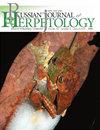橄榄海龟(Lepidochelys olivacea)的甲壳鳞片变异:聚合是一种进化趋势
IF 0.9
4区 生物学
Q3 ZOOLOGY
引用次数: 0
摘要
甲壳鳞纹是海龟的一个重要形态特征,具有系统发育稳定性的同时,也具有较高的种内变异性。橄榄脊海龟(Lepidochelys olivacea; Cheloniidae)的鳞片极不稳定,我们研究的目的是确定该物种的躯壳鳞片变异范围。我们研究了来自斯里兰卡南部海岸 9 个自然群落的 655 只 L. olivacea 幼体,发现了 120 种不同的鳞片形态。脊椎鳞和胸膜鳞变化最大,数量从四五个到十个不等。五对胸鳞是某些种类海龟的正常情况,但只有 11.9% 的个体有这种情况。椎骨和胸骨上有六对和七对鳞片的幼龟数量最多。在 92.7% 的个体中,13 对边缘鳞片是稳定的标准。具有对称鳞纹的新生龟占多数(60.9%)。通过比较不同批次孵出的幼龟的鳞栉变异情况,可以发现存在特定的鳞片模式。我们认为,不同批次的差异更多地与繁殖龟的遗传特征有关,而不是受环境因素的影响。L.橄榄海龟独特的多变固着现象表明了鳞片聚合的趋势,这在海龟进化过程中是一种罕见的现象。本文章由计算机程序翻译,如有差异,请以英文原文为准。
Carapace Scute Variations of the Olive Ridley Sea Turtle (Lepidochelys olivacea): Polymerization as an Evolutionary Trend
The carapace scute pattern is an important morphological feature of turtles that, along with the phylogenetic stability, has a high level of intraspecific variability. The olive ridley sea turtle (Lepidochelys olivacea; Cheloniidae) demonstrates extreme instability of pholidosis, and the aim of our study is to identify the range of the carapace scute variations in this species. We studied 655 L. olivacea hatchlings from nine natural clutches on the Southern coast of Sri Lanka and identified 120 different patterns of carapace scutes. The vertebral and pleural scutes were the most variable, ranging in number from four or five to ten. Five pairs of pleural scutes, a normal condition for some species of sea turtles, were found in only 11.9% of individuals. The hatchlings with six and seven scutes in the vertebral and pleural series were the most numerous. 13 pairs of marginal scutes were the stable norm in 92.7% of individuals. Newborn turtles with symmetrical scute patterns predominated (60.9%). Comparison of the pholidosis variability in hatchlings from different clutches revealed the presence of specific scute patterns. We assume that the clutch differences are more related to the genetic characteristics of the breeding turtles than to the influence of environmental factors. The unique variable pholidosis of L. olivacea demonstrates a trend toward scute polymerization, a rare phenomenon in turtle evolution.
求助全文
通过发布文献求助,成功后即可免费获取论文全文。
去求助
来源期刊

Russian Journal of Herpetology
ZOOLOGY-
CiteScore
1.70
自引率
0.00%
发文量
29
期刊介绍:
Russian Journal of Herpetology is an international multi-disciplinary journal devoted to herpetology. Russian Journal of Herpetology accepts original papers on ecology, behavior, conservation, systematics, evolutionary morphology, paleontology, physiology, cytology and genetics of amphibians and reptiles.
Types of Contributions:
-original papers
-invited or contributed reviews on specific topics
-short communications on topics of immediate interest, new methods and ideas in progress
-notices of meetings, symposia, and short courses
-book reviews
 求助内容:
求助内容: 应助结果提醒方式:
应助结果提醒方式:


